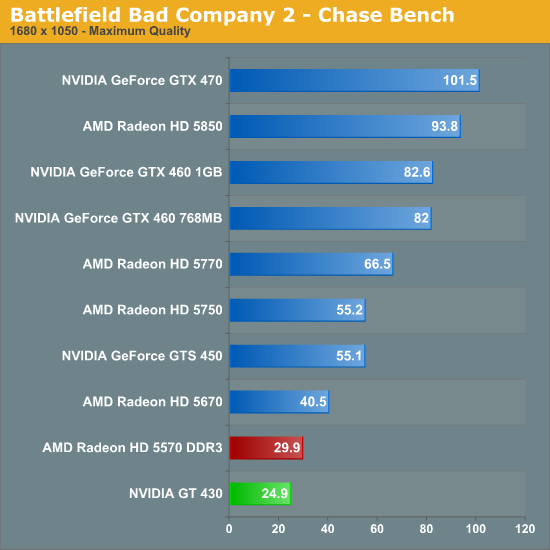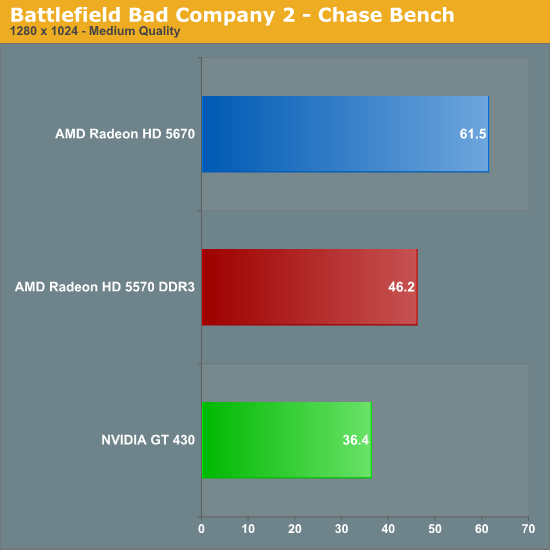NVIDIA's GeForce GT 430: The Next HTPC King?
by Ryan Smith & Ganesh T S on October 11, 2010 9:00 AM ESTBattlefield: Bad Company 2
The latest game in the Battlefield series - Bad Company 2 - is another one of our new DX11 games and has been a smash hit at retail. It’s also surprisingly hard on our GPUs, enough so that we can say we found something that’s more demanding than Crysis. As BC2 doesn’t have a built-in benchmark or recording mode, here we take a FRAPS run of the jeep chase in the first act, which as an on-rails portion of the game provides very consistent results and a spectacle of explosions, trees, and more.


Bad Company 2 was an AMD showcase title for their DX11 cards, so it probably shouldn’t be a surprise that AMD does well here. In this case the 5570 has a 10fps lead and the 5670 extends that to 25fps, which leads to the GT 430 being playable, but the 5670 is buttery smooth here. As popular as the game is it’s hard to ignore the results; much like Crysis this is a barometer title of great importance.










120 Comments
View All Comments
Stuka87 - Monday, October 11, 2010 - link
The software they used in HQV 2.0 (Which they clearly state).And the software does not do all the processing. It only does the processing if there is no GPU to offload it too (ie: Very CPU intensive).
The GPU's drivers have a LOT to do with the image quality.
ganeshts - Monday, October 11, 2010 - link
Sorry guys, could have been more clear in the testbed setup. I will update the piece accordingly.Anyways, we use Cyberlink PowerDVD build 2113 with TrueTheater disabled and hardware acceleration enabled for playing back the HQV streams.
Please note that this is the HQV 2.0 benchmark suite, and has been tailored for HD unlike the DVD oriented HQV 1.0 suite.
hmcindie - Tuesday, October 12, 2010 - link
The POINT is to get the image to the screen 100% accurately. Not to enable noise removal (scoring noise removal, "edge enhancement" or anything other "improvements" are extremely dubious)Scoring video resolution after these "improvements" is silly. Some of those deinterlacing tests are also stupid because the only way to score a perfect 5/5 score is to make the drivers detect THAT EXACT scene. An algorithm which is more universal cannot get 5/5. That alone completely negates a lot of HQV tests.
The point of HQV is to make a suite of tests and ONLY products that have been HQV certified will pass them. A lot of those tests are synthetically fabricated especially now with Blurays.
ganeshts - Wednesday, October 13, 2010 - link
Interesting point, and I won't argue against your views (because they may be correct).However, stuff like cadence detection is independent of the stream. You are either capable of 2:2 pulldown or not. It has nothing to do with a particular stream. It is aspects like this which are problematic with the GT430.
MadMan007 - Monday, October 11, 2010 - link
It's a shame NV gave up trying even for mere performance parity. With even 8 ROPs (16 would have been great) and/or GDDR5 this might have been a suitable low-end/older game budget card and possibly a worthy successor to the late great 9600GT. Adding GDDR5 alone won't fix the lack of ROPs though and probably won't make a noticable difference unlike the GT 240 where the GDDR5 variants were notably better. Too bad because a lower-end/older game silent low power draw budget gaming card is exactly what I'd be interested in, and AMD drivers are too quirky for me.smookyolo - Monday, October 11, 2010 - link
I guess you skipped over the part where it said that this is NOT a gaming card?nitrousoxide - Monday, October 11, 2010 - link
We don't need low-end gaming card, neither do we need HTPC card anyway 'cuz Llano Fusion APU will wipe them out. The game is over for nVidia at low-end.ggathagan - Monday, October 11, 2010 - link
Yes, that *was* stated, and then followed by 9 pages of gaming benchmarks.If you're going to state that the card isn't meant for gaming, then don't run game tests and fill the article with gaming benchmarks.
There are 2 only pages discussing HTPC performance.
We all know it's targeted to HTPC, so expand your reporting on that aspect of the card's abilities.
MadMan007 - Monday, October 11, 2010 - link
I guess you skipped over the part where it said that the chip is a step back in terms of graphics-oriented functional units in favor of HTPC features?It's clear this isn't a gaming card, but the potential for making it a passable gaming card that is actually competitive with the going-on-10+-month old lower-end Radeons is what I'm lamenting. I generally prefer NV cards but doing worse than their previous product in this segment (saying it's meant to replace the horrid GT 220 is a joke) is just sad. It's all part of the 'more features, no better price/performance' trend in all but the high-end that's been going on for a year though so whatever..
nitrousoxide - Monday, October 11, 2010 - link
I don't know what's wrong with Mr.Huang, but doesn't he even feel ashamed to bring this c-r-a-p to the market?! The AMD Fusion APU will easily overrun it. There will be no future for nVidia if Huang keeps making such pathetic products. The release of HD6800 is in a few days, the first tests show that HD6850 can beat a GTX460 1GB and HD6870 easily overrun the GTX470 (and probably the incoming 384SP-GF104-GTX475). Once the good days for GTX460 are gone, nVidia will be in total disadvantage.